

 |
||
 |
||
Vol. 5 (2): November 2002 |
Download this article
|
|
CONSERVATION ACTIONS ON THE CABO BLANCO PENINSULA – A NEW APPROACHPablo Fernández de Larrinoa, Ingrid Mozetich and Miguel Angel Cedenilla
The 1992 expedition to this remote and politically disputed area of Mauritania / western Sahara took place 4 years after the French researcher, Didier Marchessaux, met a tragic and untimely death in a landmine explosion. Up until 1994, the expeditions that followed had as their main objective the reassessment of written knowledge left by Marchessaux, Morales-Agacino and other researchers who intermittently worked along this coast. Intensive field work focused on identifying caves, beaches and other landmarks described in this bibliographic record. Breeding caves were relocated, as were other sites formerly occupied by seals – including once-important, yet geologically unstable, breeding caves that subsequently collapsed. A basic monitoring of the colony also commenced at this time (see the results in González et al. 1997). From 1995 until 1998, a project financed primarily through the European Union LIFE programme concentrated on further detailed scientific research in the Cabo Blanco colony. Many of the current publications available on the subject are products of those years of intensive research. Throughout this extended period of time, however, few if any conservation actions were applied in the area, which was heavily exploited by shellfish fishermen, who would descend from the cliff-tops to the beaches, caves, and anywhere else that goose barnacles might be harvested. Numerous artisanal pirogues also fished along the Coast of Seals, often as close as 40 meters to the entrance of the breeding caves.
|
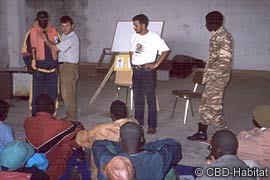 |
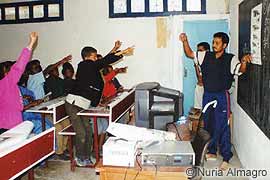 |
|
|
Safety-at-sea courses for artisanal fishermen |
Conservation education comes to Mauritanian schools |
Highest on the list of reported concerns was safety at sea – accidents which annually claimed several dozen lives – and also potentially serious health hazards arising from poor conservation and hygiene conditions under which the fish is sold in the city.
Accidents at sea, we discovered, were often caused by lack of knowledge. Many of these fishermen, in fact, have no seafaring traditions but migrated to the coast from interior regions, escaping from drought and attracted by the development of the fishing industry. A lack of means also prevented them from investing in safety equipment for their boats.
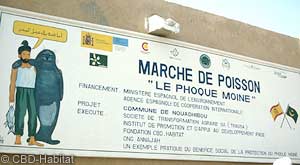 |
|
|
The new artisanal fish market in Nouadhibou |
As a result of our study, over the past two years 360 fishermen have been trained in safety at sea, enabling them to predict and avoid dangerous situations, and also to react correctly in emergencies. We also provided them with safety equipment, such lifejackets, flashing emergency lights, position lights for the pirogues, foul-weather gear, first aid kits, etc.
Also, in conjunction with the city Council of Nouadhibou, the first artisanal fish market has recently been built in the city, helping to solve hygiene and fish conservation problems that were adversely affecting the health of the local population.
At the same time, environmental education and awareness courses were organised in conjunction with the Mauritanian Institute for Fisheries and Oceanographic Research – INROP -– (formerly known as CNROP), with artisanal fishermen, 70 school teachers and 2000 pupils of primary and secondary schools participating.
All of these combined activities have resulted in a better understanding of the need to protect the monk seals in the region, and have encouraged local participation in the conservation process.
Local artisanal fishermen, for example, have now agreed not to fish in a designated area along the "Coast of Seals", which contains the two main breeding caves at its core.
This area, covering around 6 km of coast, has been marked with red flags to designate its boundaries. Since artisanal gillnet fishing in the area takes place from 0 to 500 meters from the coast, the signals placed to mark the area are clearly visible to the fishermen.
At the same time, on land, the area has also been marked to deter fishermen and shellfish collectors. An intensive patrolling of the area has been necessary to discourage their presence in locations critical for the seals – such as caves and open beaches – and to persuade them to fish in alternative areas.
During this process, the surveillance team has had to take action on numerous occasions to prevent their presence in seal breeding areas. Today, however, human intrusions by land have been virtually eliminated. Observation posts established for our guards allow monitoring of the area without the risk of causing disturbance to the seals below.
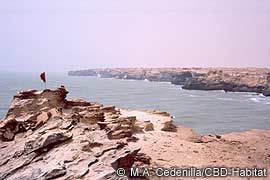 |
|
|
The Coast of Seals protection zone, marked by red flags |
The realisation of this controlled terrestrial and marine zone represents an important result for the project and an important step towards the conservation and recovery of the Cabo Blanco seal population. Combined with reinforcement by the National Park of the Banc D'Arguin authorities of the Satellite Reserve of Cap Blanc, these efforts are leading to a much improved protection for monk seals in the area.
Since the beginning of this project, the number of adult or juvenile animals found dead (i.e. not including pups), has decreased from 4 animals respectively in 2000 and 2001, to 1 this year.
Seven of those carcasses were found prior to reaching an effective agreement with artisanal fishermen in September 2001, while only 2 were discovered subsequently.
All of the social development actions were implemented by the Fundación CBD-Habitat, in conjunction with the company Tragsa and the NGO Ipade.
While these initiatives were underway, many other conservation priorities were also being pursued in the colony – as reported in previous issues of TMG.
Monitoring of breeding caves has been undertaken on a daily basis since the inception of the project, allowing the identification of each season's newborn pups and their mothers. This has enabled us to resume work on constructing a reproductive history of breeding females, an effort that was brought to an abrupt halt following the mass mortality of 1997.
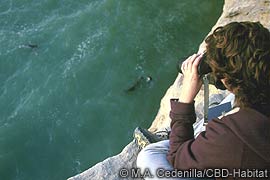 |
|
|
Identification of monk seal individuals from the Cabo Blanco cliff-tops |
The continuous monitoring of the pups until their first moult at two months old has allowed us to determine the annual pup survival rate and to compare the results with external factors such as sea and weather conditions. In conjunction with the Spanish Ministry of Environment and the Spanish Institute of Meteorology, we are also developing a model which would allow us to correlate weather conditions at the coast with the models of high sea conditions generally used by meteorological institutions. This model, we hope, will prove useful in predicting storm conditions potentially lethal for newborn pups. Maintaining the link between nature conservation and social issues, such information will also enable us to issue weather alerts to artisanal fishermen.
Individual identification of males and non-reproductive females is also performed via cameras installed in the caves, and from photographs taken from the cliff-tops.
While it is a key priority, the monitoring of the coast is not confined to the meridional points of the marked protection area. Periodically, monitoring also takes us as far south as the tip of the Cabo Blanco peninsula, in order to find monk seal carcasses for necropsy or to rescue pups that have been swept away from the breeding caves.
So far, one pup has been rescued in this way, and following rehabilitation by INROP, with the technical assistance of the SRRC of Pieterburen, it was released with a satellite transmitter set-up by Fundación CBD-Habitat. The small size of the transmitter allowed us to track the movements of the animal until the end of its battery life, 45 days after release [see Rescue, release and post-release monitoring of Weam, TMG 5 (1): May 2002 and Weam is one year old, this issue]. The animal, known as "Weam", which means 'concord' in the Arabic dialect, was also monitored visually, with local artisanal fishermen also contributing sightings information. As related in the last issue of TMG, Weam continues to be observed regularly, the animal often hauling-out on an open beach near the seal colony.
Fundación CBD-Habitat technicians have also spent time onboard fishing pirogues, gathering information on fishing grounds, fishing gear, and interactions with seals. Numerous interviews have also been conducted to gain further information on sightings of seals, particularly in locations where our technicians cannot reach.
The success of this project can, we believe, be attributed to the combination of diverse actions applied, involving diverse fields of expertise and funding sources. This interdependence has tended to magnify positive results throughout the project, but particularly in encouraging the involvement of the local community in the conservation process.
González, L.M., Aguilar, A., López-Jurado, L.F., Grau, E. 1997. Status and distribution of the Mediterranean monk seal Monachus monachus on the Cabo Blanco peninsula (Western Sahara-Mauritania) in 1993-1994. Biological Conservation 80: 225-233.
Copyright © 2002 Pablo Fernández de Larrinoa, Ingrid Mozetich, Miguel Angel Cedenilla, The Monachus Guardian. All Rights Reserved |